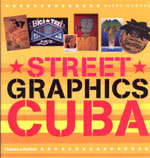Street Graphics Cuba | |

| Cuba seems all of a sudden to be terminally trendy again. I guess maybe it all started with Buena Vista Social Club, a movie and 'event' that I personally found to be singularly dull, and culminating recently with the Manic Street Preachers pulling off some kind of strange stunt playing a rock show (documented on the telly with the embarrassingly titled Our Manics In Havana), after which Castro allegedly agreed with Mr Wire that it had indeed been 'louder than war.' Sometimes I wonder what goes on in that man's head... Mr Wire's I mean, not Castro's. Obviously. I wonder how long it will be before the portrait of Che once again dominates the walls of 'young people' everywhere, usurping, oh, to show my age and how out of touch I am, Destiny's Child and Westlife. And to take a tangent at this point, is it just in Exeter, or are Arena stores the country over plugging at the old staple of James Dean wandering moodily down a NY street again? The old loop of culture at work again... hmmm. So. Cuba. The Manics have now broken down the barriers and taken good ole Capitalist Rock Music to the Socialist masses. Hurrah for them. Reversing the direction of cultural infiltration, however, is Street Graphics Cuba (Thames and Hudson). Whilst being an undeniably glorious and infectious explosion of colour and fascinating image, the book nonetheless makes me think of several issues which I suspect are more to do with me than with the book's author/photographer Barry Dawson. There's something about the way that more mediated cultures depict places like Cuba that is vaguely unsettling. I can never quite shake the feeling that it's all very condescending, a bit like 'look at what they do with discarded soda cans! They make them into little toys! Isn't that QUAINT!'. I can almost hear the squeals of delight as the photographers and writers document it all, all the time seeing cartoon dollar signs in their eyes as they imagine how many glossy magazine spreads they can monopolise. How many books they can publish. Which as I have suggested already probably says much more about me than it does about anything else, but that's okay. Perhaps others are less cynical than I am. Sometimes I hope so, other times not... There's a concern that when other industries fail a country and a culture turns to 'leisure' and 'tourism', then any real development of that culture stops. The feeling I can't shake is that once a style is established as being popular, it becomes the de facto tradition, and that thereafter the true roots of that style are lost. For example, looking through this book I am seduced by many of the images, and know that the appeal behind many of them is connected to the fact that they are images which have grown out of a need; that economic and social constraints (there's no mass produced road signs, so people paint their own, for example) have driven the process of creation. If the Cuban economy grows thanks to its tourist trade to the point where mass production of road signs is easy, are the hand painted signs (a sign themselves of the style that tourists come to see) replaced, or are they left in place because to affect change would be to risk upsetting the status-quo, would destroy the very essence that leads to prosperity. It's a concern that ought to make many tourists uncomfortable but probably doesn't. For another example take the revolutionary murals that are so beautifully documented in the book: are we saying that we want to go to Cuba to re-visit some quaint 20th Century political and social experiment? Where the tourists turn up and sigh 'ah Revolutionary Socialism, what a marvellous concept' and then escape back to their technologically advanced homes, hanging that repro revolutionary poster on their wall next to the Warhol Marilyn poster. And I'm as guilty of this as the next person, incidentally. Maybe I am conveniently skirting over the fact that pre-revoltionary Cuban culture was always a bizarre and exciting mix of cultures where Hispanic met South American and had an uneasy affair with North American exploitation, and that post-revolutionary development is no more or less important in the scheme of things than what happens now and in the next fifty years. Of course too maybe I'm just being old-fashioned. Maybe I am missing the point that in our po-mo times of post-political/idealism, no one actually cares about any underlying social reasons for what we see around us, only that it looks in some way interesting, or that it fits with this season's fashion and with the colour scheme of the living room. And maybe, in the light of this, books like Street Graphics Cuba are actually life-lines, are actually the cracking open of doors that lead towards more exploration, the things that give us the opportunity to evaluate and to think things through for ourselves. It certainly worked on me. © Alistair Fitchett 2001 Street Graphics Cuba is published by Thames and Hudson. £12.95. |